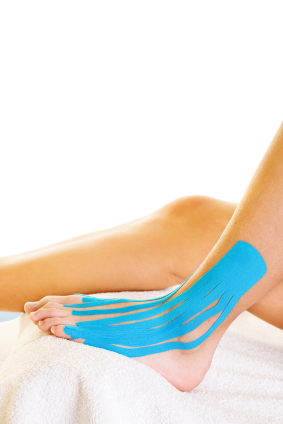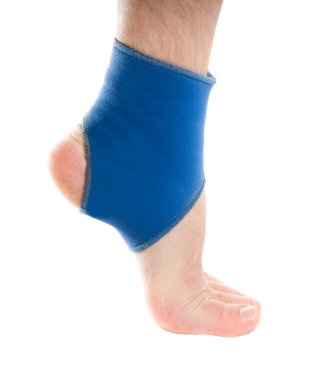Featured
Foot Rehabilitation for Athletes
It is hard to think of a sport in which the ankle and foot are completely safe from injury. Even simple activities such as darts and pool can cause injuries to the foot. When an athlete does suffer from a foot injury, he needs to find a way to get back on his feet right away. Immediate results may be desired, but they are not always possible.
Severe injuries require special attention. When the foot or the ankle gets injured, muscles surrounding the bones can weaken or atrophy through disuse. While the bones will heal on their own, it takes a more concentrated effort for an athlete to regain full use of his feet and ankles. A doctor may recommend that a person go through a course of physical therapy. The course of physical therapy treatment uses simple, repetitive isometric exercises. The use of the exercises will cause the body to rebuild the muscles and tendons in the area over time and restore the full range of movement.
When selecting ankle and foot rehabilitation services, an athlete needs to find a licensed sports therapist (other physical therapists work with more generalized conditions, and while these kinds of physical therapists are dedicated to their job, they do not necessarily understand the special demands of the athlete). A good sports therapist will take their time with a patient, and make sure that he or she understands the problem and the options available for treatment.As long as the doctor expects a person to return to the sport which he enjoys, the sports physical therapist will recommend the exact exercises a person needs to get back in the game.
Although the professional athlete needs a trained sports therapist, an amateur athlete or the weekend player can benefit from foot rehabilitation services for athletes as well. An ankle or foot injury does not have to cause a person go give up the game he loves entirely, so long as he or she seeks out a sports therapist.
Physical therapy can not always perfectly heal certain injuries, but it will more quickly and effectively help the afflicted person get better. Less severe injuries may only take a person out of his favorite sport just for a little while, if he or she sees a sports therapist. As long as the doctor the athlete sees thinks a full recovery is possible, it is worth it to check out ankle and foot rehabilitation services.
Playing sports with foot injuries
There are many types of foot injuries common among athletes such as plantar fasciitis, overpronation, strains, turf toe, heel spurs, and stress fractures of the foot. Plantar fasciitis is when the thick ligament in the base of the foot becomes swollen, and causes pain. Overpronation is excessive movement of the foot during gait. Pronation would be normal movement of the gait, but when movements become excessive, it leads to a variety of areas becoming painful due to the overpronation. The most common complaint is a burning sensation or inflammation under the arch of the foot, often called strain or arch pain. Heel spurs are growths of the bone in the heel where soft tissues and tendons connect. Turf toe comes from upward bending of the big toe outside of the normal range of motion. It most commonly occurs in athletes that play on artificial surfaces because a shoe grips the surface and forces and athletes weight forward causing the upward bending of the large toe. This causes damage by stretching the ligaments under the toe. Stress fractures could be caused by overuse due to muscle fatigue in the foot, preventing the muscles and ligaments from absorbing the shock and trauma.
Many athletes continue to play with mild foot injuries. You should remember to properly stretch before any activities, focusing on their calves to prevent injuries and reduce reoccurring pain. It is also common to wear braces to protect the areas that commonly become overstretched and use shoe inserts such as heel pads. It is important to remember to wear proper footwear and replace shoes when needed.
There are many kinds of treatments required to keep the injury from becoming serious. Most commonly an athlete should immediately ice the injury to take down swelling and inflammation. Applying a compression bandage and resting will also reduce pain and stress on the foot. Rest could include using crutches to keep weight off of the injury to allow proper healing, for instance. For plantar fasciitis, make sure calves are properly stretched and refrain from hills or speed work. One should try wearing an arch strap to add support. Those with heel spurs should also try arch straps to reduce strain and ice often. The best remedy would be heel pads. Aside from that, one would need a podiatrist or orthopedic specialist. It may require surgery. Those who are suffering from overpronation or turf toe should invest in a quality shoe to reduce motion. There are special insert and braces for the big toe, as well as shoes with firm soles to prevent bending. Stress fractures usually require rest, so an athlete may participate in lower impact activities to allow rest and healing. Most importantly, one should seek medical advice if pain does not go away or recurs frequently.
Systemic Diseases of the Foot
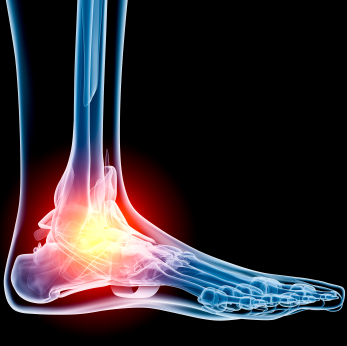 There are several systemic diseases, or diseases that affect the whole body, that either display symptoms in the feet or affect the health of the feet. Common systemic diseases that affect the overall health of the feet, and the patient’s ability to walk comfortably, include gout, diabetes mellitus, neurological disorders, and arthritis.
There are several systemic diseases, or diseases that affect the whole body, that either display symptoms in the feet or affect the health of the feet. Common systemic diseases that affect the overall health of the feet, and the patient’s ability to walk comfortably, include gout, diabetes mellitus, neurological disorders, and arthritis.
In gout, which is caused by an excessive buildup of uric acid in the body, the most common symptoms of pain, inflammation, and redness occur at the metatarsal/phalangeal joint at the base of the big toe. Any excess levels of uric acid crystallize and are deposited in tendons, joints, and surrounding bone and muscle tissue. Gout is commonly treated with NSAIDs to relieve pain and inflammation and other drugs to lower uric acid levels in the body. Gout most commonly affects those who are overweight, have low protein diets and lead a more sedentary lifestyle.
Diabetes mellitus is an increase in the level of blood sugar which the body cannot counteract with naturally occurring insulin in the body. The three types of diabetes, Type I, Type II and Gestational Diabetes, are all signs the body is either not producing enough insulin or is not efficiently using the insulin that is produced. Gestational diabetes only affects women who are pregnant and have never, prior to pregnancy, exhibited symptoms of the disease.
There are two main issues that affect the feet that are commonly caused by diabetes. They include diabetic neuropathy and peripheral vascular disease. Diabetic neuropathy can lead to damaged nerves and affect the feet through numbness and loss of sensation. Peripheral vascular disease restricts the flow of blood to the foot and can, in extreme cases, lead to the necessity of amputating the foot. Peripheral issues that are caused by diabetes and can affect the foot include athlete’s foot, nail infections, corns, blisters, bunions, severe dry skin, plantar warts and ingrown toenails. These can all be attributed to the decrease of blood flow to the foot.
Neurological disorders and rheumatoid arthritis can also have severe impact on the health of the feet. Neurological disorders can affect the nerves in the main structure of the foot and cause loss of sensation and possible decreased muscle response. Rheumatoid arthritis can affect the bones and joint structures of the foot, making it impossible to walk normally without serious pain.
All systemic diseases that affect the foot can effectively be treated to minimize joint and muscle damage if they are diagnosed early and treated with medication and lifestyle therapy. Diabetes patients must monitor their blood sugar levels and work with their physician to keep their levels as close to normal as possible. Rheumatoid arthritis patients should work with their physician to ensure the proper medications are being taken to reduce the amount of damage to the joints of the body.
Nerve Disorders of the Foot and Ankle
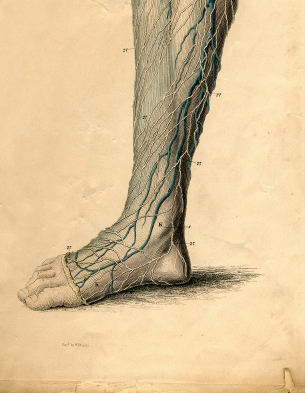 Similar to well known nerve disorders in the hands, such as carpal tunnel syndrome, nerve disorders that affect the foot and ankle occur in patients for reasons ranging from stress to genetics. Nerve disorders of the foot should be addressed right away because they may be immobilizing in serious cases. Two of the most common nerve disorders of the foot and ankle are Interdigital Neuroma and Tarsal Tunnel Syndrome.
Similar to well known nerve disorders in the hands, such as carpal tunnel syndrome, nerve disorders that affect the foot and ankle occur in patients for reasons ranging from stress to genetics. Nerve disorders of the foot should be addressed right away because they may be immobilizing in serious cases. Two of the most common nerve disorders of the foot and ankle are Interdigital Neuroma and Tarsal Tunnel Syndrome.
Interdigital Neuroma is caused by localized inflammation of one of the nerves that controls toe sensitivity in the frontal area of the foot. This inflammation is generally only found in the second or third interspace, and any other symptoms similar to Neuroma on other digits should be checked against other disorders. Symptoms include chronic burning or tingling sensations between the affected toes which can, at times, migrate to the toes themselves. This pain is often increased by walking, running, or by wearing shoes that compress the toes, such as high heels. A doctor should be consulted if this pain is chronic and if the symptoms get worse.
Typical examinations to determine the presence of Neuroma include radiographs, MRIs, and even bone scans of the affected area. Bone scans are only required if degeneration of bone is suspected, however. Surgery is often not required to alleviate the symptoms of Neuroma, and in many cases functional orthotics can be used to alleviate the stress of constant weight on the affected toes. Surgery is recommended for those patients that suffer from symptoms for 6 months or more, so reporting symptoms early can increase the rate of non-surgical recovery.
Tarsal Tunnel Syndrome, a condition that is less common than Interdigital Neuroma, is similar to Carpal Tunnel Syndrome in that it is caused by a compression of the nerve caused by any number of factors (mostly associated with excess pronation). Typically seen in those that have either flatfeet or valgus heel positions, Tarsal Tunnel Syndrome has patients complaining of moderate to severe ankle pain that starts along the bottom of the foot and often proceeds to the calf. Some more extreme cases occur with partial numbness and even atrophy of the foot and surrounding muscles.
If there is a good chance that someone has Tarsal Tunnel Syndrome, an EMG test is often used to diagnose the condition. If the diagnosis is positive, an MRI can be used to identify the compression of the nerve. Treatment with NSAIDS, functional orthotics, and rest off of the feet is often prescribed, but again, long standing symptoms require surgery, as do exacerbated symptoms caused by lesions present between nerves.
Heel Pain
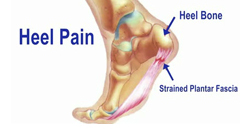 Heel pain is a stressful condition that affects day to day activities. Running and walking causes stress on the heel because the heel is the part of the foot that hits the ground first. This means that the heel is taking on your entire weight. Diagnosis and treatments for heel pain can be easily found through your podiatrist.
Heel pain is a stressful condition that affects day to day activities. Running and walking causes stress on the heel because the heel is the part of the foot that hits the ground first. This means that the heel is taking on your entire weight. Diagnosis and treatments for heel pain can be easily found through your podiatrist.
One of the main causes of heel pain is a condition known as plantar fasciitis. The plantar fascia is a band of tissue that extends along the bottom of the foot, from the toe to the bottom of the heel. A rip or tear in this ligament can cause inflammation of these tissues, resulting in heel pain. People who do not wear proper fitting shoes are often at risk of developing problems such as plantar fasciitis. Unnecessary stress from ill fitting shoes, weight change, excessive running, and wearing non-supportive shoes on hard surfaces are all causes of plantar fasciitis.
Achilles tendonitis is another cause of heel pain. Similar to plantar fasciitis, inflammation of the Achilles tendon will cause heel pain due to stress fractures and muscle tearing. A lack of flexibility of the ankle and heel is an indicator of Achilles tendonitis. If left untreated, this condition can lead to plantar fasciitis and cause even more pain on your heel.
A third cause of heel pain is a heel spur. A heel spur occurs when the tissues of the plantar fascia undergo a great deal of stress, leading to a separation of the ligament from the heel bone entirely. This results in a pointed fragment of bone on the ball of the foot, known as a heel spur.
Treatments for heel pain are easy and effective as long as problems are addressed quickly. The most common solution is simply taking stress off the feet, particularly off of the heel. This will ease the pain and allow the tendons and ligaments to relax. In the case of both plantar fasciitis and Achilles tendonitis, icing will reduce swelling of any part of the foot and anti-inflammatory medication is highly recommended. Properly fitting your shoes and wearing heel pads or comfort insoles will also reduce the risk of developing heel pain. Stretching before and after exercises such as running will help the foot muscles prepare for stress and lower the chances of inflammatory pain. In extreme cases, relieving heel pain might require surgery. Always make sure to discuss these symptoms and treatment options with your podiatrist to keep yourself active and pain free.
Keywords: Heel pain, Achilles Tendonitis, Plantar Fasciitis, Heel Spur, Heel Pain Treatment, Stress on the Foot, Foot Tissue Tear, Foot Inflammation
What Is A Podiatrist?
The branch of medicine that is focused on the treatment, diagnosis, and study of disorders of the lower leg, ankle and foot is referred to as podiatry. Because people often spend a great deal of their time on their feet, many problems in this area can occur. A person seeks help from the field of podiatry when they need treatment for heel spurs, bunions, arch problems, deformities, ingrown toenails, corns, foot and ankle problems, infections, and problems with the foot that are related to diabetes and additional diseases.
To treat problems of the foot, ankle or lower leg, a podiatrist may prescribe physical therapy, drugs, perform surgery, or set fractures. Individuals may also be recommended to wear corrective shoe inserts, custom-made shoes, plaster casts and strappings in order to correct deformities.
When trying to gather information on a patient problem, a scanner or force plate may be used in order to design orthotics. During this procedure, patients are told to walk across a plate that is connected to a computer; the computer then takes a scan of the foot and indicates weight distribution and pressure points. The computer readouts will give the podiatrist information to help them determine the correct treatment plans.
Diagnosis is also provided through laboratory tests and x-rays. Through the foot, the first signs of serious problems such as heart disease, diabetes and arthritis can show up. For example, individuals that have diabetes may frequently have problems such as infections and foot ulcers because they experience poor circulation in the foot area. A podiatrist can then have consultations with patients when symptoms arise and referrals will be made to specialists that handle the greater health problems.
Some podiatrists have their own solo small private practices or clinics where they have a small staff and administrative personnel but many work within group practices. They usually spend time performing surgery in ambulatory surgical centers or hospitals or visiting patients in nursing homes. They typically spend between 30 to 60 hours of week working. Some podiatrists specialize in public health, orthopedics, surgery, or primary care. Some other fields include specialties in geriatrics, dermatology, pediatrics, diabetic foot care and sports medicine.
Some podiatrist specialists complete extra training in the area of foot and ankle reconstruction that result from the effects of physical trauma or diabetes.
How To Choose a Podiatrist
Injuries of the foot can be very difficult problems to diagnose. Most general practitioners are only equipped to deal with relatively easy types of foot injury. If it is any more serious than a mild sprain to the ankle, then it is a better idea to seek the assistance of a podiatrist. These doctors specialize in the treatment of the foot, and therefore are better able to give you an accurate diagnosis when dealing with such issues.
In order to go and see a podiatrist, you will usually have to get a referral through your general practitioner or family doctor. Since they are specialists, sometimes this is the only way that they will take on a new patient. It may also be a requirement of one's insurance agency to do things this way.
Before choosing a podiatrist, it’s a good idea to look into what type of podiatrist you need. There are a few areas of specialization within the field of podiatry. Sports podiatry focuses on sports-related injuries and implementing a plan of action that can get the injured players back into the activities they are into. Bio-mechanical podiatry specializes in knowing precisely which way the foot should move in everyday life. These are the more general doctors that can instruct you in day to day pain. Surgical podiatrists focus on fixing foot issues through surgical means. They are usually a last resort, and you will normally get referred to one from a more general type of foot doctor if necessary. When selecting a podiatrist, it is crucial that you make sure you choose one that best fits the problems that you are having. A sports based doctor is not going to be the best choice if you are suffering from diabetes related foot issues, for instance.
The best way to research a foot doctor in your area is generally with a simple internet search. There are a variety of sites that will give reviews based on customer experiences with different doctors. This can be a great source of information, but it does not always give a full picture of the doctor's performance. Many people only take the time to review something when they have had a negative experience. This can skew the results so keep this in mind during your research. It's also a good idea to request a suggestion from your family doctor. Try to ask them on a personal level, like who they would refer a family member to. If you do it this way, you may get a better recommendation.
Choosing A Podiatrist
A doctor who specializes in treating foot disorders such as warts, bunions, calluses, hammertoes, ingrown toenails, heel pain and corns is called a podiatrist. Most people tend to ignore the feet, which should not be the case as they play just as important a role as other parts of the body.
Choosing a podiatrist should be accorded the same seriousness you would use when choosing any other doctor. Do your homework and make sure you get the kind of podiatrist you need.
Finding a podiatrist shouldn't be difficult. Ask your friends, physician, relatives, the local hospital, insurance companies, surf the Internet, look in the telephone directories and advertisements both on the radio and on newspapers.
Ask around about a podiatrist or do some research online before setting up an appointment. Nurses are good sources of information as they work closely with doctors and understand them. Other avenues you need to consider are the medical boards, as well as referral patients that have been treated by the same doctor. Also, it is a good idea to find out whether the podiatrist you are interested in is involved in and knowledgeable about the latest treatment options and procedures. This is especially important for those with serious foot problems.
So you have found the specialist you like, but are you comfortable enough with him? Your comfort should be given priority, as you will be spending a considerable amount of time with him. The only way to find this out is by booking an appointment with him and observing his attitude toward you, toward other patients, and toward his coworkers. A good podiatrist should be able to put a patient at ease as well as explain problems and procedures. They should be willing to spend as much time as necessary to help a patient understand his or her condition and the options available to them.
The next thing to be considered is cost. Fees should not be exorbitant, but cheap can also be expensive. You may think that you have found the best deal only to make a later discovery that the hospital you settled for is not well equipped and offers substandard treatment. If this is the case, the problem you are being treated for may not be resolved as smoothly as it should. Fees should be reasonable and the receptionist or office manager should be ready to help with any financial concerns you might have.
Videos
About The Podiatry Center, Featuring Dr. Howard Hyman, DPM, FACFAS
Foot and Heel Pain, Featuring Dr. Howard Hyman, DPM, FACFAS
Patient Testimonial - Ingrown Toenail
Custom Orthotics, Featuring Dr. Karyn Goldberg, DPM, FACFAS
Diabetic Foot Care, Featuring Dr. Nathan Jennato, DPM
Ingrown Toenails, Featuring Dr. Nathan Jennato, DPM
Patient Testimonial - Joint Replacement
Enriched Plasma Protein, Featuring Dr. Karyn Goldberg, DPM, FACFAS
Insurance
We accept many various HMOs, PPOs, and other health insurance plans. Call our office today to make sure our office accepts your insurance carrier.
Accepted Health Insurances
We accept the following Health Insurances:
AHP
Amerihealth
Americaid
Americhoice
Anthem Health
Better Health Network
ChoiceCare
Cigna Healthcare (All)
Consumer Health Network
Empire Blu Choice
Empire Blue Cross & Blue Shield
Empire Healthchoice
Empire Medicare
First Health
Footcare Network
GHI
Healthpayors Organization (HPO)
Horizon Blue Cross & Blue Shield
Horizon HMO Blue
Integrated Health Plan
Mercy Health Plan
Magnacare
Medichoice
MHBP
Multiplan
NALC-National Asso.Letter Carriers
One Health Plan
Oxford
United Heathcare
PHCS
Healthnet
Qualcare
St. Barnabas Health System
Wellchoice
More...
Directions
New Patient Forms
Patient Forms
Please print and fill out these forms so we can make your first visit as efficient as possible:
In order to view or print these forms you will need Adobe Acrobat Reader installed.
Application Article
{chronocontact}applicatiion{/chronocontact}
Patient Education
Our podiatric specialists and staff members work together to ensure that the health of our patients is the absolute best it can be. We strive to improve patient health by focusing on preventing, diagnosing, and treating feet ailments and conditions. Please use our podiatric library to learn more about podiatric problems, as well as treatments available. If you have any questions or need to schedule an appointment, please feel free to contact us.
